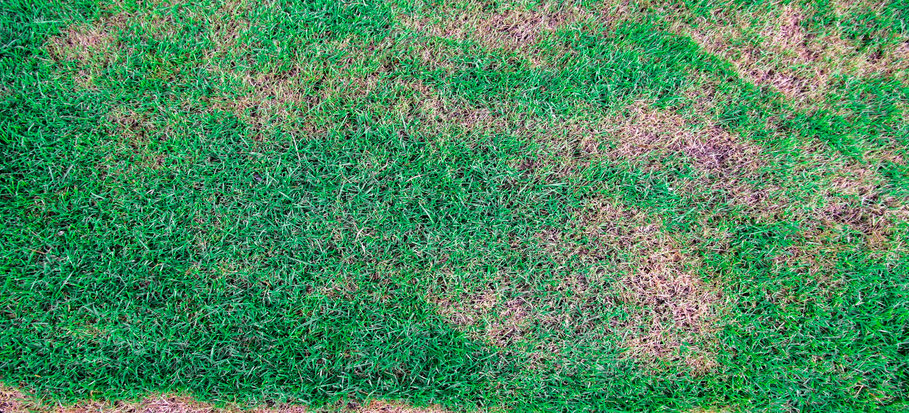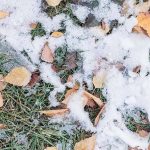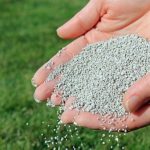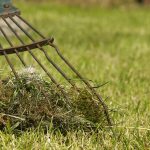
When it comes to keeping your lawn in good condition, disease control is really important. Not all grasses are vulnerable to the same diseases, and sometimes even a well managed and healthy lawn can be affected by fungal outbreaks. Here in the UK, it rains quite often, and when the weather is favourable, numerous fungi can develop, especially if your turf is under stress.
So, if you see:
- Patches of light brown and bleached turf;
- Small and pink cottony flocks on the turf;
- Red strands growing from the grass blade;
Then yes, you are looking at the red thread disease. So, keep on reading to find out how to combat it.
What is the red thread lawn disease?
The red thread disease is one of the common fungal lawn diseases that you can find in the UK. The fungus Laetisaria fuciformis stays dormant in the soil or thatch layer, and when the conditions are favourable for spreading, it causes visible patching on the grass.
This particular lawn fungus adores humid and mild weather and temperatures between 15 – 25 degrees Celsius. That’s why it attacks in late spring to summer and can persist into winters if the weather is cool and humid.
The red thread disease tends to be more of an annoyance than a fatal disease, as it doesn’t kill the root of the grass and usually, your lawn is quite healthy. But it causes the grass leaf to die, thus giving the lawn a patchy and unsightly appearance.
Symptoms of the red thread disease
If your lawn has become infected by red thread, you might notice the following symptoms:
- Lawn patches with a red tint at first, that become brown over time. Sometimes, they might even look bleached in appearance;
- The size of the patching varies between 8 cm and 25 cm in diameter; however, in some cases, a bigger area can suffer damage;
- The appearance of the fungal infection might vary. For instance, you might see a red, pike-like growth on the grass blades, or have a pinkish flocky growth that resembles snow (don’t mix with pink snow mould). Either way, both growths indicate the presence of red thread in your lawn.
What causes red thread in your lawn?
Some lawns and grass types tend to be more prone to red thread than others. The disease can be more severe on red fescue, but bents, perennial ryegrass and annual meadow grass can also be prone to infection.
The way we take care of our lawn can alter its malleability and resilience to the fungus. The red thread fungus will affect underfed and unhealthy grass, but we also noticed it on some of the UK’s healthiest and best-kept lawns.
Most of the time, the victims of red thread are lawns with lower fertility levels, particularly lacking in nitrogen. When the plants experience slower growth due to the lack of nitrogen, the disease becomes more widespread. If an area of the lawn is fertilised, but some parts remain unfertilised, you will get more damage from the disease in this area. That’s why you want to fertilise your lawn evenly and regularly.
Also, the following conditions may increase the severity of the attacks:
- Lawns that are overwatered, especially frequent evening watering.
- Young lawns that have not had the chance to build stability.
- Lawns that are stressed by drought or heat.
- Old and tamped lawns.
How to get rid of red thread in your lawn?
Most of the outbreaks can be cured by simply fertilising the lawn. Well-preserved roots and grass can outgrow the damage, and the ugly spots can disappear. Note that it can take a few years for the red thread treatment to work through the disease and stop it from reappearing.
The most important red thread control measure is to maintain a healthy nitrogen and potassium balance in the turf to promote growth. Do not apply the fertiliser after August, otherwise, you risk the production of soft and vulnerable growth that is prone to other fungal diseases, like snow mould.
Treating red thread with chemicals is not necessary and not recommended in residential lawns. Most lawns recover over time, but they might have a faded look for a while. However, if the infection is severe, the best course of action will be to apply trifloxystrobin – a fungicide for red thread control. This solution can be used at any time of the year; however, it’s not recommended to apply the fungicide during drought and in winter, when the lawn is still frozen.
Before the use of fungicide, make sure that you really are dealing with the red thread disease in your turf and consult a professional lawn care expert.
In general, if you take good care of your lawn and apply nitrogen fertiliser regularly, there will be no need for fungicides. Your lawn may still get some outbreaks, but it won’t be as bad as an unfertilised one.
How to prevent red thread in your lawn?
The best course of action to prevent red thread from appearing in your lawn is regular maintenance and garden hygiene.
Over time your lawn can become compacted due to heavy rains, overwatering and constant foot traffic, making it harder for water to go through. Lawns with poor water retention levels are more vulnerable to fungal attacks. The increased humidity in the turf, in combination with high temperatures, creates a perfect ground for fungi to strike. Aerating your lawn can help with water transmission and air penetration.
Heavy layers of cut grass create ideal conditions for fungi to thrive. After mowing, always dispose of the cuttings that you don’t plan to compost. Grass cuttings from a diseased lawn should not be used in compost, as it can once again spread the disease. Moreover, if your lawn had a red thread outbreak, make sure to remove and clean your lawnmower brushes to reduce the chances of re-infecting the lawn.
Ensure that the soil has sufficient levels of nitrogen by regularly feeding your lawn with nitrogen-rich fertiliser.
Is your lawn in bad shape?
Don’t worry, Fantastic Services can bring it back to life! The lawn care plan we create is personalised to your preferences and your turf’s needs, so you can be sure that your lawn will stay healthy all year round.
The gardening teams we send are proficient enough to perform a large variety of lawn care services, including aeration and fertilising. Dedicated to their job, the gardeners always come fully equipped with everything needed to leave your turf looking neat and clean after every visit.
Would you like to have a flawless garden? Then book a professional lawn care service with Fantastic Services, today!
Need a professional?
Find a professional to take care of your property.

Takeaways
- Red thread disease is one of the most common fungal diseases of turf in the UK.
- It is not necessary to use fungicides for the control of red thread lawn disease. Consistent garden maintenance and regular fertilising should be one of the first remedies against this fungal infection.
- The best way to control red thread disease is to avoid overwatering your lawn and fertilising inconsistently, and maintaining the hygiene of your gardening tools.
***
Did you find this post helpful? Do you have any lawn care tips to share? Leave a comment down below!
Image source: shutterstock/CHALERMPHON SRISANG


